| We had some difficulty in identifying the flute below, or even
suggesting a country of origin. There is some lettering visible on
it, but not clear enough to make an identification. There is
however a maker's mark: |
| Four 6-pointed stars appear on the upper body, two on the lower body
and one on the foot, just below the Eb key plate. As can be seen,
stars may not be the best description. Perhaps asterisks or
snowflakes? Note also the somewhat irregular spacing. |
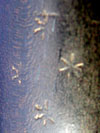 |
|
The breakthrough came when European professional flute
player, Georges Barthel, contacted me to say he had one rather like it,
and, although the maker's mark was worn, he was able to make out the
name Larshof. Bravo, Georges!
Larshof
So, who was Larshof? As usual, we turn to the flutemaker's
bible, The New Langwill Index. Interestingly, we don't find a
Larshof, but we do find an entry for Jacob Georg Larshoff. Even
more interestingly, we find his mark was: *
Larshof * Presumably, his real name was
as the marks indicate, and the NLI tossed in an extra "F". Unless
perhaps the directories of the time listed him as Larshoff.
The NLI goes on to tell us that he was born in Wolgast in Swedish
Pomerania circa 1760, and flourished as a flutemaker in Copenhagen in
Denmark between 1798 and 1834. He gained Danish citizenship in
1810, when he was appointed as Court instrument maker. He
exhibited a contrabassoon in 1813, and a patent for a new clarinet
key-mechanism in 1821. He died in Copenhagen on 1 February 1846,
succeeded by his nephew Johan Dajon Rudolph.
|
About the flute
The flute itself is ebony, with ivory mounts, brass tuning slide and
nine silver keys.
Note the G# key is mounted below the break between the
left and right hand sections. |
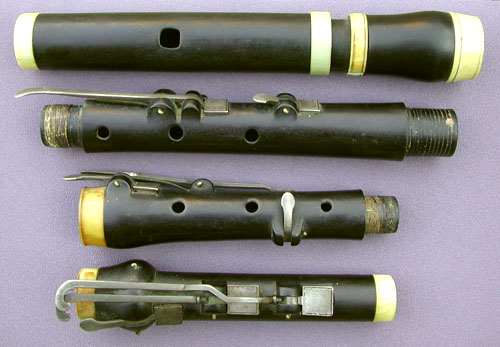 |
| Note also the additional key on the
upper section, probably a D trill. This key is strangely placed -
equally inconvenient to thumb and first-finger, so perhaps intended to be
operated by either? |
| Note also the c key is mounted on the same block as the Bb
key, making for an
unusual balance point. |
 |
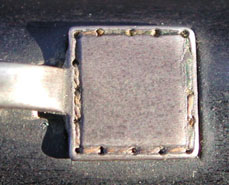 |
Perhaps the most intriguing feature relates to how the leather pads
are secured to the key-plates. As you can see on the left, they
are sewn! Presumably fine adjustment of pad seating was achieved
by bending the thin metal of the shaft. |
The embouchure
The "Early TV-shaped" embouchure hole is an
interesting and conspicuous
feature. It's about 9.55mm wide from left to right, narrowing to
around 9 near the corners. From front to back, it's about 9.2mm,
narrowing to around 8.4mm near the corners. The corners are rounded
a little. |
|
Left undercutting is about 1.1mm, right 2.1mm, front and
back around 1 mm. The walls are not quite straight, but suggest a
primary and secondary taper, particularly on the sides. The metal
slide is cut well further back on all but the left (stopper) edge. |
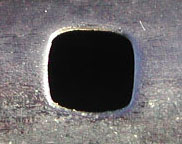 |
Finger holes
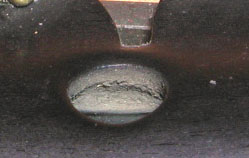
|
The finger holes are interesting too.
Undercutting is hardly the word - these holes have been undergouged!
The undercutting along the length of the flute is normal if extensive, but
across the flute, they have been scooped out vigorously, leaving a
concavity on each side. |
Dimensions (mm)
|
| Head: |
|
Length of head (including rings)
Protrusion of slide
Embouchure centre to lower end of head
Head bore
Outside diameter at the embouchure . |
141
35.6
75
19.4
29.3 |
| Barrel: |
|
Protrusion of slide
Length of barrel body |
21.7
62.4 |
| Upper body: |
|
Upper tenon
Between tenons
Lower tenon
Bore at top
Bore at lower end |
|
25.3
155.5
21.3
18
15 |
|
Diameter |
From top |
Hole 1
Hole 2
Hole 3 |
6.4
6.5
5.7 |
99
135
170 |
| Lower body |
|
|
Top to start of tenon
Lower tenon
Bore at bottom |
|
137
17
12 |
|
Diameter |
From top |
Hole 4
Hole 5
Hole 6 |
6.05
5.85
5.1 |
47.3
82.2
118.2 |
Length
Bore at bottom |
|
157
11.8 |
Tuning
As you can see, it's not currently playable, so tuning is a bit of a
guess. We can expect it to perform best somewhere around 425Hz.
Georges advises that his similar instrument works well at 430Hz.
Acknowledgements
My thanks to the flute owner, Rob Boyle, for the opportunity to
examine this lovely and intriguing piece of work, and to Georges Barthel
for identifying it.
Back to the McGee Flutes Index Page
Created 25 Feb 2002, last updated 24 Sep 2013 |
|